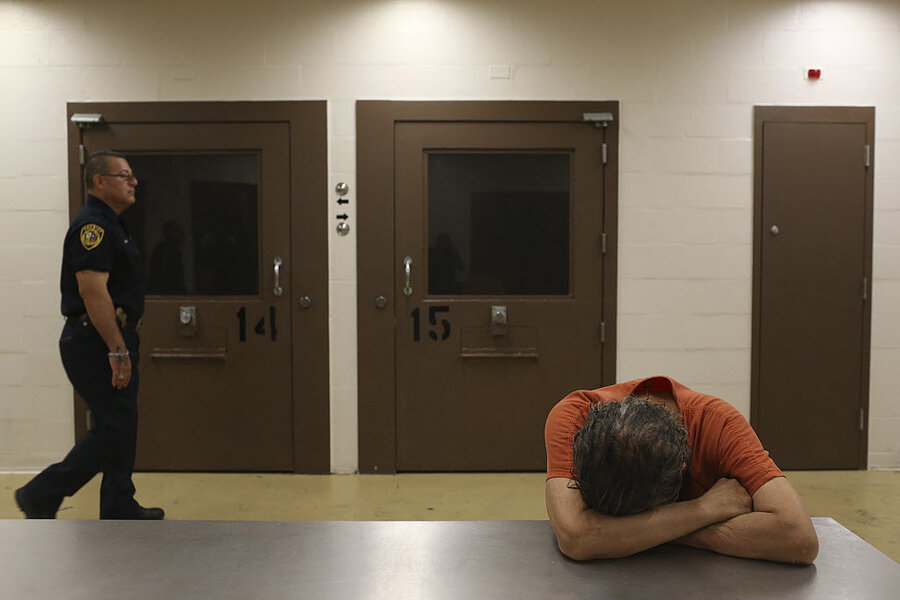Why jails' embrace of video visiting technology can harm inmates, families
Loading...
The announcement trumpeting a new program at one Texas county jail sounded almost cheery. “People will be able to visit their loved ones and schedule those visits from the comfort of their home, office, or anywhere equipped with a computer, camera and high speed Internet access,” the 2013 statement said. “Getting started is easy!”
But behind the sunny tone lay a harsher reality. Opportunities to visit inmates at the Travis County Jail would now be offered only through Skype-like video technology. Lacking Internet access meant coming to the jail complex in Del Valle, Texas, in-person, only to be greeted by another video screen.
Families and advocates for justice reform say the technology has harmful effects on inmates, making them increasingly isolated because such visits are often conducted from special pods or day rooms, not from a central visiting room, a report by the Massachusetts-based Prison Policy Initiative found.
They also point to the high cost of at-home video visits – Travis County charges $20 for 20 minutes – often funneled back to the private companies that make the technology. Using a computer terminal at the jail, by contrast, is free, reports NBC News.
“It just seems so impersonal," Ashika Coleman-Carter, who drives out to the jail complex twice a week to see her husband Keith, told NBC in January. “The old visits, even though you couldn't touch behind the glass, at least you could go into an actual visiting room and see someone's face. Now you can't get close to the person at all,” she adds.
Citing rising costs of housing the nation’s estimated 2.3 million prisoners, many state and local governments have increasingly embraced the technology. More than 500 jails in 43 states are now using video visitation technology, according to PPI’s report.
The Justice Department has also weighed in, saying in a 2014 report the technology is becoming “more commonplace, affordable, and accessible. But, it cautioned, “video visiting should not be deemed as an invitation to discontinue in-person visiting.”
More than two years later, Travis County’s video-only policy remains in effect, though that may be changing.
State law now requires that all county jails provide inmates with two twenty-minute in-person visits each week, but lawmakers have granted exemptions for about 30 jails because they had already spent significant amounts installing the video technology, local non-profit Grassroots Leadership found.
On Monday, the Texas Commission on Jail Standards indicated that they plan to review the exemption granted to Travis County because the jail’s 2012 contract with Securus Technologies indicates that the company would pick up the tab for the program, not taxpayers, the Austin American-Statesman reports.
The company agreed to pay the cost of installing the video technology – an estimated $750,000, according to the Statesman – because it could make money charging for at-home visits, raising concerns that the county did not significantly invest in the technology itself.
But County Sheriff Greg Hamilton told the paper that the stated cost was for an earlier expansion of video technology to the jail’s maximum-security facilities and a newly constructed building, before Securus became involved in expanding video visits to the entire jail.
He says he always intended to move toward video-only visits in Travis County, but as concerns about the program grow, he may be open to revising the jail’s policy. “I don’t have a problem with it,” he told the Statesman. “It’s a good thing to allow those individuals to have the face-to-face visits.”
In addition to concerns about impacts video visits can have on inmates, there are also questions about whether the video technology essentially punishes families hoping to see their loved ones.
People like Ms. Coleman-Carter – whose husband was sentenced to about 45 days in jail for “resisting search” – are often caught in a quandary, NBC reports. Lacking Internet access at home, they decide to visit via public terminals in the jail complex. But video visits can often be marred by technical problems like a poor signal connection or other glitches.
And even if families are able to obtain an Internet connection to use the technology, the high cost of each visit can often keep them away, increasing many inmates’ sense of isolation, which may have an effect on what they do after they are released, research shows. For example, prison visits can reduce an inmate’s rate of recidivism by 13 percent, with even a single visit having an impact, a study by the Minnesota Department of Corrections found.
“Seventy-three percent of the people in our jail have not been convicted – that means they are innocent until proven guilty," Dallas County Judge Clay Jenkins, who opposed ending in-person visitation in local jails, told NBC. “And 100 percent of their family, their spouses and their children are innocent, who are the people who end up paying for this.”





